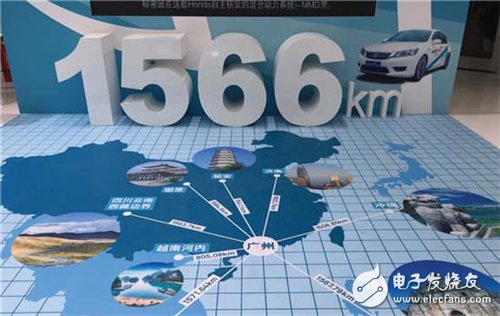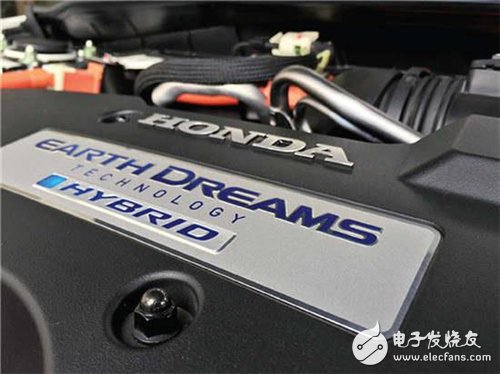When a Hybrid Accord can use a tank of oil for more than 1,500 kilometers, you will doubt that such products and technologies will not be accepted and recognized by the market? This is the strong signal that "technical control" Honda released this year.
Following the hybrid driver Toyota, Honda is determined to use a strong technical force to promote the popularity of hybrid power in China, and technically surpass Toyota, which accounts for more than 60% of global hybrid power, becoming the Honda hybrid in China. The best driving force.

What technology is the Toyota Motors surrender?
In September of this year, Honda FUNTEC HYBRID "One Box of Oil, Go!" Intercity Challenge kicked off in major cities. A box of oil is about 60L. For ordinary models, the average owner knows how far the distance of a tank of oil can be, especially with a 2.0L engine. However, the mixed version of the Accord has produced amazing results. The maximum speed of the average fuel consumption of 3.83L per 100 kilometers is 1,566 kilometers, which is equivalent to a box of oil from Beijing, across Tianjin, Inner Mongolia, to Yinchuan, FUNTECHYBRID The second challenge was a satisfactory answer.
This is the achievement and ability that Toyota, known as the "king of hybrids", is hard to match. The outstanding performance of the hybrid version of the Accord and the magical power of the i-MMD hybrid system made Toyota have to bow down.
Although Toyota is the top player in hybrid technology and even new energy technology, and patents for hybrid technology, the technically controlled Honda has achieved the ultimate in hybrid technology with its i-MMD hybrid system, whether it is power output or fuel consumption. And other related indicators, there are too many.
At the Guangzhou Auto Show this year, the FUNTEC technology area exhibited a hybrid version of the Accord model equipped with FUNTEC HYBRID technology. The i-MMD hybrid system used in this car reached a new height in terms of power performance, fuel consumption and acceleration.
What are the advantages of Honda FUNTEC HYBRID technology? In comparison with Toyota, you may understand. Toyota's hybrid system adjusts the ratio of hybrids, while Honda's hybrid technology switches between "electric drive mode", "hybrid drive mode" and "engine drive mode". Cut off or restore the connection between the engine and the motor according to the driving conditions.
In normal driving, the i-MMD hybrid system is driven by a drive motor for most of the time. For example, driving in an urban area, the engine is almost not used to directly drive the vehicle. The engine only provides power indirectly, thus enabling The lower fuel consumption makes the hybrid version of the Accord with the i-MMD hybrid system fuel consumption as low as 4.6L per 100 km.
Therefore, from the perspective of technological advancement, Honda's i-MMD system is indeed slightly higher. In fact, when Honda just released the system last year, Toyota has also admitted that Honda has three hybrid systems for different models, and that the power can be switched between power transmission and mechanical transmission. Honda is temporarily leading. A colleague once tested the mixed version of the Accord and thought that the hybrid version of the Accord can achieve the power level of the Acura TLTYPE-S and the Accord 3.5L, while the fuel efficiency reached the level of the third generation.
The i-MMD hybrid system consists of a 2.0L Atkinson cycle dual overhead camshaft (DOHC) gasoline engine with dual motors, power control unit PCU and voltage control unit, high-power lithium-ion battery, etc. The automatic switching responds efficiently to various situations, and the advantages of energy saving and emission reduction are outstanding. It can simultaneously achieve the world's highest level of fuel economy and smoothness, and has the driving characteristics of sports characteristics.
At the same time, in addition to its advantages in hybrid technology, Honda also emphasizes driving quality and driving pleasure, which will have a considerable impact on the entire hybrid vehicle market and even new energy vehicles, indirectly improving all the depots. The standard. In this sense, Honda's FUNTECHYBRID is comparable to the impact of VTEC's variable valve lift technology on the gasoline engine for passenger cars at the time.

Honda Hybrid Evolutionary History
A long time ago, the fuel consumption and power of a car were almost like fish and bear's paw, and it was difficult to have both. For example, once the American car and the German car, in order to pursue good power and control, it is necessary to use a large displacement power system, but the direct consequence is that the price of the car is more powerful. Power and control.
In today's era of increasingly serious pollution and fuel shortage, environmental protection and energy-saving technologies have become a major trend in the development of automotive technology. Many car companies attach great importance to the environmental protection and energy-saving technologies of automobiles and start to reduce the emission of automobile pollutants. In particular, after the exposure of the Volkswagen diesel engine emissions fraud incident, it triggered a global discussion on environmental technology. Therefore, new energy power technology has been paid more and more attention by car companies, and has accelerated the pace of research and development, including pure electric and hybrid power vehicles.
When it comes to hybrid vehicles, the first thing consumers think of is Toyota. The keywords such as Prius and Twin Engine have almost become the labels of Japanese hybrid vehicles. However, in addition to Toyota, Honda has a strong technical accumulation in hybrid technology, but Honda's hybrid road is easily overlooked.

In the 1997 J-VX concept car, a hybrid system called IMA first appeared. In 1999, J-VX was launched in volume production and its name became Insight. Since then, IMA's hybrid system has been carried on the Civic, Accord, CR-Z and Acura brand models.
So, what is the technical principle of IMA? It belongs to the parallel hybrid system. The engine is the main source of power, and the motor is auxiliary. It can only be regarded as moderate hybrid, and the position of the motor in the overall system is not high. Based on the rest-cylinder technology, the engine can shut down the oil supply and intake and exhaust of the cylinder according to the driving conditions, and the pure electric driving can be realized at low speed cruising. However, since the engine crankshaft and the motor are still connected in this process, although the oil supply is stopped, the cylinder and the crankshaft remain in operation, and still consume a certain amount of energy. Although the technology has undergone several generations of updates, the essence of the IMA is Not much change. In Toyota's hybrid system, the engine and the motor can be completely disconnected. At this level, Toyota's THS is more advanced than IMA.
Aware of the shortcomings of the IMA hybrid system, Honda, which has always attached importance to technology research and development, has begun to make changes in hybrid systems. Competitor Toyota has insurmountable barriers to hybrid technology. Therefore, Honda must independently develop a technical system of its own and compete with it to gain a foothold in the market.
Last year, Honda won the title of “technical house†and launched a new generation of FUNTEC HYBRID hybrid technology, and this trip went out three. The first is the i-DCD (Intelligent Dual ClutchDrive) system using a motor, which is mainly used in compact models such as Fit and Civic. The second is the i-MMD (Intelligent MulTI ModeDrive) system with two motors, which is mainly used in medium-sized cars such as the Accord. The third is the Sports Hybrid SH-AWD with three motors, which are mainly used on large vehicles such as the Acura RLX.
The advantage of this subdivision scheme is that it can adapt different hybrid systems according to the positioning and requirements of different models, which is obviously more targeted than the previous package. Because each model has their own requirements for power, economy, and handling, specific questions should be analyzed.

A Battery Charger supplies current to the base plate. Once the AGV is in charging position and the collector has made contact with the base plate, the AGV computer turns on the current.
The base plate has chamfered entry/exit ramps to facilitate smooth drive-on/drive-off of the spring loaded collector.
A battery charging contact consists of a base plate, which is installed on the floor or laterally at a bracket adjacent of the AGV runway, and a current collector which is installed on the vehicle.
Battery charging stations may be installed anywhere within the system where the production process allows the AGV to stop (staging areas, turn arounds, loading stops etc.).
Single Phase Charging Contacts
Single Phase Battery Charging Contacts,60A Battery Charging Contacts,100A Battery Charging Contacts,Single Phase Charging Contacts
Xinxiang Taihang Jiaxin Electric Tech Co., Ltd , https://www.chargers.be